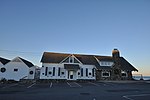Little River (New Hampshire Atlantic coast)
New Hampshire river stubsRivers of New HampshireRivers of Rockingham County, New Hampshire

The Little River is a 4.6-mile-long (7.4 km) river in southeastern New Hampshire in the United States. It is located entirely in the town of North Hampton, and it flows directly into the Atlantic Ocean, south of Little Boars Head. The river rises in a forested wetland in the northern part of North Hampton and flows south, passing under U.S. 1. The river turns southeast, passes through Mill Pond and under NH 111, and enters the Little River salt marsh. The river enters the Atlantic Ocean by passing under NH 1A, using a new, large culvert installed by the New Hampshire Coastal Program in an effort to improve tidal flow into the salt marsh.
Excerpt from the Wikipedia article Little River (New Hampshire Atlantic coast) (License: CC BY-SA 3.0, Authors, Images).Little River (New Hampshire Atlantic coast)
Kings Highway,
Geographical coordinates (GPS) Address Nearby Places Show on map
Geographical coordinates (GPS)
| Latitude | Longitude |
|---|---|
| N 42.956666666667 ° | E -70.778611111111 ° |
Address
Kings Highway
Kings Highway
03871
New Hampshire, United States
Open on Google Maps









